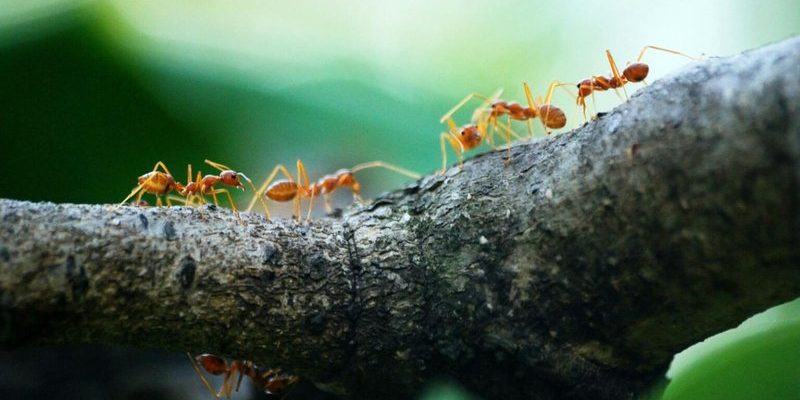
So, how do ants communicate? Think of them like tiny smartphones, using various signals instead of texts or calls. They rely on a combination of chemical signals, touch, and sound to convey messages and organize their activities. This article dives into the world of ant communication and interaction, revealing the intricate dance of teamwork in their colonies.
The Language of Ants: Chemical Signals
One of the primary ways ants communicate is through chemical signals called pheromones. Imagine you’re at a big party, and instead of shouting over the music, you send notes to your friends. Ants do something similar by leaving chemical trails to share information. These pheromones can signal everything from food sources to danger.
When an ant discovers food, it releases a trail pheromone as it returns to the colony. Other ants pick up on this scent and follow the trail to the food. This simple yet effective method helps the colony work as a team, ensuring everyone benefits from the food source. It’s like sending a group text to let everyone know where the pizza party is!
However, pheromones can also alert other ants to danger. If an ant senses a predator, it will release an alarm pheromone, prompting its fellow ants to either flee or prepare for defense. It’s a perfect example of how ants prioritize colony safety and survival.
Touch and Ant Interaction
Another vital aspect of ant communication is tactile signals. Ants often use their antennae to feel and touch one another. This is particularly important when ants are working closely together or need to identify colony members.
For example, if an ant encounters another ant, it might gently touch the other’s antennae. This is like a handshake—a way to say, “Hey, I’m from your colony!” This tactile interaction helps maintain strong social bonds within the colony, promoting cooperation and teamwork.
You might also see ants cleaning each other. This grooming not only keeps their exoskeletons clean but also strengthens their social ties. Think of it as a form of “ant friendship”—by taking care of one another, they’re enhancing group cohesion.
The Role of Sound in Ant Communication
Though it might not be as common as pheromones or touch, sound plays a role in ant communication as well. Some species of ants make sounds (often called stridulation) by rubbing parts of their bodies together. This can serve various purposes, such as alerting others or signaling distress.
Imagine a concert—each ant produces its own unique “note” that contributes to the overall harmony or chaos. While not all ants can hear in the same way, those that can use these sounds to communicate important information, like when it’s time to retreat or reorganize.
For instance, when a colony faces a threat, a particular sound might signal an immediate response to protect the queen and brood. In this way, ants demonstrate the power of sound as a tool for survival and coordination.
Division of Labor: How Ants Work Together
Ant colonies have a fascinating social structure that allows them to function smoothly. Within a colony, you’ll find different groups of ants performing specific tasks. This division of labor is crucial for their survival and success as a community.
Worker ants, for example, handle foraging, nest maintenance, and caring for the young. Some may be scouts, exploring and searching for food, while others may act as soldiers, guarding the colony. Each ant has a role, and as they communicate through pheromones and touch, they can coordinate their efforts effectively.
This teamwork is essential. For example, when a worker ant finds food, it quickly communicates this to other workers through pheromone trails, prompting a well-organized foraging party. It’s a superb illustration of how effective communication leads to successful outcomes for the entire colony.
Ant Communication in Different Species
Not all ants communicate the same way. Different species have evolved unique methods tailored to their environments and needs. For instance, leafcutter ants use pheromones not just for food location but also for coordinating complex tasks of cutting leaves and transporting them back to their nests.
In contrast, army ants rely heavily on sound and tactile signals during their aggressive foraging raids. They need to be highly coordinated to ensure they can overpower prey efficiently. Each species has adapted its communication methods based on survival strategies, showcasing the incredible diversity in the ant world.
Understanding these differences helps us realize that communication among ants isn’t just a simple act—it’s a complex system honed over millions of years.
Why Ant Communication Matters
So, why should we care about how ants communicate? For one, studying ant communication can illuminate broader concepts in biology and ecology. Their social behavior offers insights into the nature of cooperation, organization, and even human social interactions.
Moreover, ants play crucial roles in their ecosystems as decomposers, predators, and prey. By understanding their communication methods, researchers can learn how to protect their habitats and maintain ecological balance.
Additionally, scientists are exploring how ant communication can inspire technologies in robotics and artificial intelligence. The way ants work together can offer lessons in efficiency and teamwork that might one day influence how we design collaborative systems.
Ants may be small, but their communication and interaction are impressively complex. From chemical signals and tactile interactions to the sounds they make, these little creatures have developed a rich language that allows them to thrive as a colony. Understanding how they work together offers us a glimpse into the wonders of nature and the beauty of collaboration.
Next time you see ants marching in a line, remember that each tiny ant is part of a bigger picture, communicating and working together in ways that are both sophisticated and essential for their survival. So, next time you’re munching on a snack outdoors, be mindful of the little workers nearby—they’ve got a lot going on beneath the surface!

